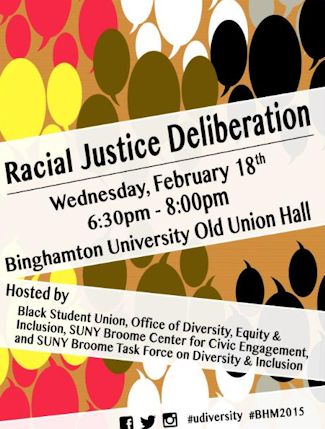From Scott Corley, a Report about Racial and Ethnic Justice Deliberations at SUNY Broome Community College
Blog Category:
The following is a report from Scott Corley on “Equality and Justice for All: How Can We Improve Racial and Ethnic Justice?” deliberations. It summarizes what happened in National Issues Forums (NIF)-styled deliberations on racial and ethnic justice that took place in Broome County, New York, during the fall and spring semesters at SUNY Broome Community College.
The image accompanying this blog post is a poster that Binghamton University used for advertising the racial justice deliberation on their campus.
OVERVIEW AND EXPLANATION
In 2013, I began thinking about how civic engagement efforts can be eloquently, deliberately, and effectively combined with efforts aimed at promoting racial justice. Eventually I decided to update and modify NIFI's Racial and Ethnic Tensions: What Should We Do? (published in 2000) so as to update the statistical information, include current events stories, and re-frame the guide away from "reducing tensions" to "promoting justice". The revised deliberation guide utilized concepts drawn broadly from social justice, peace studies, and racial justice literature and specifically from the pedagogy of Intergroup Dialogue.
The frames are as follows:
• Approach 1: Address racial and ethnic injustice and inequality on institutional and structural levels
• Approach 2: Reduce racial and ethnic injustice by extensively encouraging education / training programs
• Approach 3: Address racial and ethnic problems on an individual level
The fruits of my labor resulted in a 26 page deliberation guide (that still contains a good amount of text from the original version), a moderator’s guide, and a placemat. I've ran this deliberation on a very experimental basis involving only a handful of people twice for about an hour in the spring semester of 2014. More in-depth deliberations then took place the next academic year starting in the fall, 2014 in my Social Problems class, at an adjunct training conference, and for 25 VISTA and Americorps volunteers for 2-1/2 hours who participated in the discussion for anti-racism training purposes.
On February 17th, I ran this deliberation at SUNY Broome again with 24 attendees, half of whom were students and the other half BCC faculty and staff, for 3 hours. On February 18th, I ran this deliberation at Binghamton University, which is one of the state university’s flagship institutions, with approximately 40 students for 1-1/2 hours.
INTIAL OBSERVATIONS
My initial, and most important, observation is that the modified framework is effective. The 3 approaches “flow” into one another eloquently as they are relatively distinctive, but interconnected ways to address racial and ethnic injustice. I was pleased to notice how participants were able to discuss the approaches in and of themselves, but not without somehow referring to issues and concepts connected to the other 2 approaches. With good moderation, deliberation participants can clearly understand the major ideas associated with race, racism, and racial justice, but in relationship to advantages, drawbacks, tensions, and tradeoffs connected to various courses of action. Overall, I observed rich and informative conversations.
To increase the chances of executing this deliberation successfully, it seems vital that, similar to other deliberations, the run-time be at least 2 hours and audience (participant) composition should be as diverse as possible in every measure. I also believe that while discussion moderators need not be “experts” in social justice, cultural competency, or the like, moderation skills would no doubt be enhanced with a certain level of familiarity with major concepts and terminology associated with racial justice work. And in order to increase the chances that potential discussion participants can draw on the same information, have a base-line understanding of the topic, and are able to use the same language effectively, the modified discussion guide also needs to be shortened.
FUTURE EFFORTS
Currently, there are plans to run this deliberation in SUNY BCC’s residence halls and at Binghamton University within the next few weeks. I will also have the opportunity to have SUNY BCC students deliberate about this topic using the modified Racial Justice guide in a criminal justice class, a public policy class, and during a student club general meeting. In the spirit of expanding the use of this deliberation beyond Broome County, I have hopes that New York Campus Compact and/or the State University of New York Diversity and Inclusion Taskforce may help provide incentives, encouragement, and infrastructure for other SUNY campuses to run this forum.
It may also be noteworthy to point out that I will begin developing another discussion guide on minority communities and law enforcement. With another colleague, I am organizing a panel discussion and open forum on March 5th which I will use to begin acquiring initial data to develop the framework. The panelists include a member of City Council, a police chief, a member of the NACCP, and an ACLU branch director.
The link contains more information and news coverage of the racial justice deliberation at SUNY BCC on February 17th, http://www.wicz.com/news2005/viewarticle.asp?a=37040.
The following link contains a brief newspaper article used for advertising purposes for the deliberation at SUNY BCC http://www.pressconnects.com/story/news/2015/02/17/racial-issue-event-broome/23549099/.

